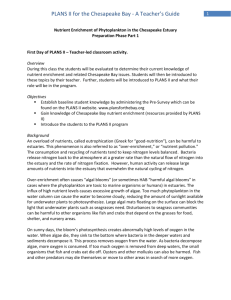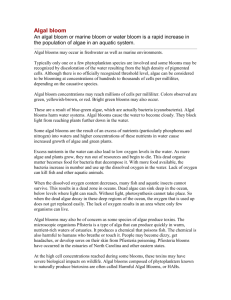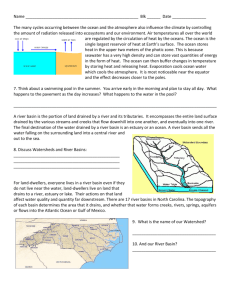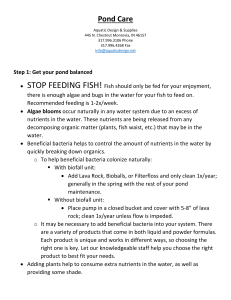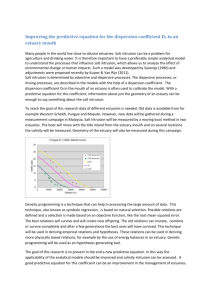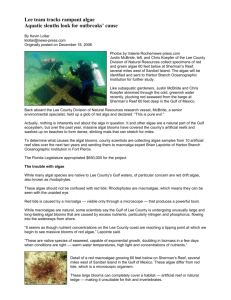Nutrients in an Estuary
advertisement
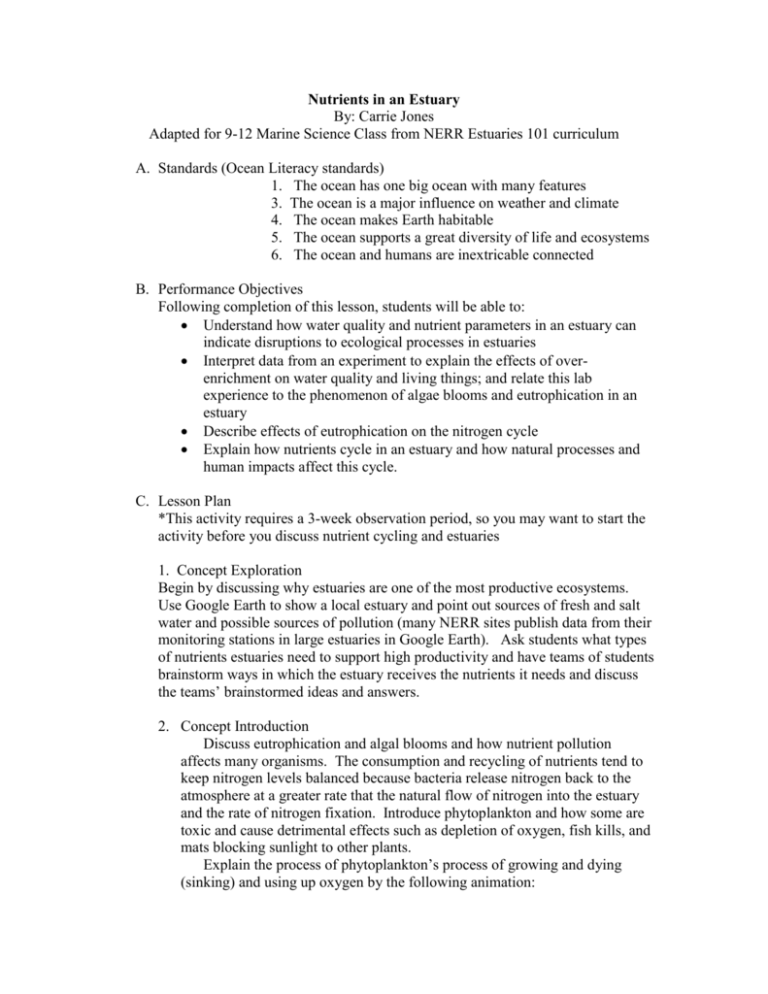
Nutrients in an Estuary By: Carrie Jones Adapted for 9-12 Marine Science Class from NERR Estuaries 101 curriculum A. Standards (Ocean Literacy standards) 1. The ocean has one big ocean with many features 3. The ocean is a major influence on weather and climate 4. The ocean makes Earth habitable 5. The ocean supports a great diversity of life and ecosystems 6. The ocean and humans are inextricable connected B. Performance Objectives Following completion of this lesson, students will be able to: Understand how water quality and nutrient parameters in an estuary can indicate disruptions to ecological processes in estuaries Interpret data from an experiment to explain the effects of overenrichment on water quality and living things; and relate this lab experience to the phenomenon of algae blooms and eutrophication in an estuary Describe effects of eutrophication on the nitrogen cycle Explain how nutrients cycle in an estuary and how natural processes and human impacts affect this cycle. C. Lesson Plan *This activity requires a 3-week observation period, so you may want to start the activity before you discuss nutrient cycling and estuaries 1. Concept Exploration Begin by discussing why estuaries are one of the most productive ecosystems. Use Google Earth to show a local estuary and point out sources of fresh and salt water and possible sources of pollution (many NERR sites publish data from their monitoring stations in large estuaries in Google Earth). Ask students what types of nutrients estuaries need to support high productivity and have teams of students brainstorm ways in which the estuary receives the nutrients it needs and discuss the teams’ brainstormed ideas and answers. 2. Concept Introduction Discuss eutrophication and algal blooms and how nutrient pollution affects many organisms. The consumption and recycling of nutrients tend to keep nitrogen levels balanced because bacteria release nitrogen back to the atmosphere at a greater rate that the natural flow of nitrogen into the estuary and the rate of nitrogen fixation. Introduce phytoplankton and how some are toxic and cause detrimental effects such as depletion of oxygen, fish kills, and mats blocking sunlight to other plants. Explain the process of phytoplankton’s process of growing and dying (sinking) and using up oxygen by the following animation: http://peconicestuary.org/Nutrients.animation.html. Algal blooms may result from natural conditions, but mostly occur from human activities (runoff). The blooms usually occur seasonally and conditions such as the amount of nutrient input, water quality, weather and the residence time affect the algal blooms. Present the students with local data (check NERR or NOAA sites for chlorophyll and/or TN data) and have them relate the findings to algal blooms. 3. Concept Application Provide samples of water (preferable from an estuary) with algae. If this water is not available you can use pond, stream, puddle or tap water. Ideally, you should use a freshwater sample and saltwater sample. For extension, you may have the students develop their own experiments by varying sunlight, pH, etc. Using beakers or clear cups, the students will fill the beakers with the water and will add differing amounts of nutrients (1 tsp, 2 tsp, 3 tsp. etc) in the form of commercial fertilizer to each beaker. Students will be monitoring the samples once a week, measuring the water quality parameters and describing the algae growth for several weeks. Take digital images of the beakers every few days in order to track the algae growth due to nutrient enrichment. See attached data sheets for making predictions and tracking the models over time. D. Review/Evaluation Relate their experiment to the nitrogen cycle and how it occurs Discuss the different parameters which effects the nutrients and are affected by the enrichment of nutrients Optional Extension: Have the students write a short letter to the town council of this region outlining their recommendations about steps to take to reduce the amount of nutrient flow into the estuary. Sources: Adapted from NERRS Estuary 101 curriculum http://www.estuaries.gov/estuaries101/Teachers/Default.aspx?ID=101 http://peconicestuary.org/Nutrients.animation.html. Name ________________ Nutrients in an Estuary- Student Worksheet Making Predictions 1a. How do you think the amount of fertilizer will affect the amount of algae in each of the samples? 1b. How do you think the algal growth will differ between the fresh and salt-water samples? 1c. How is this experiment different from conditions in an actual estuary that receives excess nutrients? Tracking the Models Over Time Examine the contents of your beakers and record your observations every two or three days over a period of three weeks. Also take a digital image every two or three days. At the end of three weeks, display all images and observe the changes in your model estuaries. 1d. How did the amount of fertilizer affect the amount of algae in each of the samples? 1e. How did the algal growth differ between the fresh and salt water samples? 1f. Explain using the process of photosynthesis how the level of dissolved oxygen varies with increasing amounts of living algae. Life Science Module—Activity 2 15 1g. Explain using the process of decomposition how the level of dissolved oxygen would vary in the beakers as the algae die and settled to the bottom.
